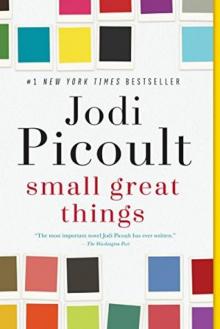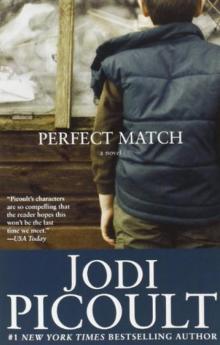- Home
- Jodi Picoult
The Jodi Picoult Collection #4 Page 2
The Jodi Picoult Collection #4 Read online
Page 2
The imminent arrival of this little sister (how strange is it that none of us ever imagined the new baby could be anything but a girl?) energized Kurt and Elizabeth to fever pitch. Elizabeth drew elaborate sketches of what the baby’s room should look like. Kurt hired a contractor to build the addition. But then the builder’s mother had a stroke and he had to move unexpectedly to Florida; none of the other crews had time to fit our job into their schedules before the baby’s birth. We had a hole in our wall and rain leaking through the attic ceiling; mildew grew on the soles of our shoes.
When I was seven months pregnant, I came downstairs to find Elizabeth playing in a pile of leaves that had blown past the plastic sheeting into the living room. I was deciding between crying and raking my carpet when the doorbell rang.
He was holding a canvas roll that contained his tools, something that never left his possession, like another man might tote around his wallet. His hair brushed his shoulders and was knotted. His clothes were filthy and he smelled of snow—although it wasn’t the right season. Shay Bourne arrived, unexpected, like a flyer from a summer carnival that blusters in on a winter wind, making you wonder just where it’s been hiding all this time.
He had trouble speaking—the words tangled, and he had to stop and unravel them before he could say what he needed to say. “I want to . . .” he began, and then started over: “Do you, is there, because . . .” The effort made a fine sweat break out on his forehead. “Is there anything I can do?” he finally managed, as Elizabeth came running toward the front door.
You can leave, I thought. I started to close the door, instinctively protecting my daughter. “I don’t think so . . .”
Elizabeth slipped her hand into mine and blinked up at him. “There’s a lot that needs to be fixed,” she said.
He got down to his knees then and spoke to my daughter easily—words that had been full of angles and edges for him a minute before now flowed like a waterfall. “I can help,” he replied.
Kurt was always saying people are never who you think they are, that it was necessary to get a complete background check on a person before you made any promises. I’d tell him he was being too suspicious, too much the cop. After all, I had let Kurt himself into my life simply because he had kind eyes and a good heart, and even he couldn’t argue with the results.
“What’s your name?” I asked.
“Shay. Shay Bourne.”
“You’re hired, Mr. Bourne,” I said, the beginning of the end.
SEVEN MONTHS LATER
MICHAEL
Shay Bourne was nothing like I expected.
I had prepared myself for a hulking brute of a man, one with hammy fists and no neck and eyes narrowed into slits. This was, after all, the crime of the century—a double murder that had captured the attention of people from Nashua to Dixville Notch; a crime that seemed all the worse because of its victims: a little girl, and a police officer who happened to be her stepfather. It was the kind of crime that made you wonder if you were safe in your own house, if the people you trusted could turn on you at any moment—and maybe because of this, New Hampshire prosecutors sought the death penalty for the first time in fifty-eight years.
Given the media blitz, there was talk of whether twelve jurors who hadn’t formed a reaction to this crime could even be found, but they managed to locate us. They unearthed me in a study carrel at UNH, where I was writing a senior honors thesis in mathematics. I hadn’t had a decent meal in a month, much less read a newspaper—and so I was the perfect candidate for Shay Bourne’s capital murder case.
The first time we filed out of our holding pen—a small room in the superior courthouse that would begin to feel as familiar as my apartment—I thought maybe some bailiff had let us into the wrong courtroom. This defendant was small and delicately proportioned—the kind of guy who grew up being the punch line to high school jokes. He wore a tweed jacket that swallowed him whole, and the knot of his necktie squared away from him at the perpendicular, as if it were being magnetically repelled. His cuffed hands curled in his lap like small animals; his hair was shaved nearly to the skull. He stared down at his lap, even when the judge spoke his name and it hissed through the room like steam from a radiator.
The judge and the lawyers were taking care of housekeeping details when the fly came in. I noticed this for two reasons: in March, you don’t see many flies in New Hampshire, and I wondered how you went about swatting one away from you when you were handcuffed and chained at the waist. Shay Bourne stared at the insect when it paused on the legal pad in front of him, and then in a jangle of metal, he raised his bound hands and crashed them down on the table to kill it.
Or so I thought, until he turned his palms upward, his fingers opened one petal at a time, and the insect went zipping off to bother someone else.
In that instant, he glanced at me, and I realized two things:
1. He was terrified.
2. He was approximately the same age that I was.
This double murderer, this monster, looked like the water polo team captain who had sat next to me in an economics seminar last semester. He resembled the deliveryman from the pizza place that had a thin crust, the kind I liked. He even reminded me of the boy I’d seen walking in the snow on my way to court, the one I’d rolled down my window for and asked if he wanted a ride. In other words, he didn’t look the way I figured a killer would look, if I ever ran across one. He could have been any other kid in his twenties. He could have been me.
Except for the fact that he was ten feet away, chained at the wrists and ankles. And it was my job to decide whether or not he deserved to live.
* * *
A month later, I could tell you that serving on a jury is nothing like you see on TV. There was a lot of being paraded back and forth between the courtroom and the jury room; there was bad food from a local deli for lunch; there were lawyers who liked to hear themselves talk, and trust me, the DAs were never as hot as the girl on Law & Order: SVU. Even after four weeks, coming into this courtroom felt like landing in a foreign country without a guidebook . . . and yet, I couldn’t plead ignorant just because I was a tourist. I was expected to speak the language fluently.
Part one of the trial was finished: we had convicted Bourne. The prosecution presented a mountain of evidence proving Kurt Nealon had been shot in the line of duty, attempting to arrest Shay Bourne after he’d found him with his stepdaughter, her underwear in Bourne’s pocket. June Nealon had come home from her OB appointment to find her husband and daughter dead. The feeble argument offered up by the defense—that Kurt had misunderstood a verbally paralyzed Bourne; that the gun had gone off by accident—didn’t hold a candle to the overwhelming evidence presented by the prosecution. Even worse, Bourne never took the stand on his own behalf—which could have been because of his poor language skills . . . or because he was not only guilty as sin but such a wild card that his own attorneys didn’t trust him.
We were now nearly finished with part two of the trial—the sentencing phase—or in other words, the part that separated this trial from every other criminal murder trial for the past half century in New Hampshire. Now that we knew Bourne had committed the crime, did he deserve the death penalty?
This part was a little like a Reader’s Digest condensed version of the first one. The prosecution gave a recap of evidence presented during the criminal trial; and then the defense got a chance to garner sympathy for a murderer. We learned that Bourne had been bounced around the foster care system. That when he was sixteen, he set a fire in his foster home and spent two years in a juvenile detention facility. He had untreated bipolar disorder, central auditory processing disorder, an inability to deal with sensory overload, and difficulties with reading, writing, and language skills.
We heard all this from witnesses, though. Once again, Shay Bourne never took the stand to beg us for mercy.
Now, during closing arguments, I watched the prosecutor smooth down his striped tie and walk forward. One big difference bet
ween a regular trial and the sentencing phase of a capital punishment trial is who gets the last word in edgewise. I didn’t know this myself, but Maureen—a really sweet older juror I was crushing on, in a wish-you-were-my-grandma kind of way—didn’t miss a single Law & Order episode, and had practically earned her JD via Barcalounger as a result. In most trials, when it was time for closing arguments, the prosecution spoke last . . . so that whatever they said was still buzzing in your head when you went back to the jury room to deliberate. In a capital punishment sentencing phase, though, the prosecution went first, and then the defense got that final chance to change your mind.
Because, after all, it really was a matter of life or death.
He stopped in front of the jury box. “It’s been fifty-eight years in the history of the state of New Hampshire since a member of my office has had to ask a jury to make a decision as difficult and as serious as the one you twelve citizens are going to have to make. This is not a decision that any of us takes lightly, but it is a decision that the facts in this case merit, and it is a decision that must be made in order to do justice to the memories of Kurt Nealon and Elizabeth Nealon, whose lives were taken in such a tragic and despicable manner.”
He took a huge, eleven-by-fourteen photo of Elizabeth Nealon and held it up right in front of me. Elizabeth had been one of those little girls who seem to be made out of something lighter than flesh, with their filly legs and their moonlight hair; the ones you think would float off the jungle gym if not for the weight of their sneakers. But this photo had been taken after she was shot. Blood splattered her face and matted her hair; her eyes were still wide open. Her dress, hiked up when she had fallen, showed that she was naked from the waist down. “Elizabeth Nealon will never learn how to do long division, or how to ride a horse, or do a back handspring. She’ll never go to sleepaway camp or her junior prom or high school graduation. She’ll never try on her first pair of high heels or experience her first kiss. She’ll never bring a boy home to meet her mother; she’ll never be walked down a wedding aisle by her stepfather; she’ll never get to know her sister, Claire. She will miss all of these moments, and a thousand more—not because of a tragedy like a car accident or childhood leukemia—but because Shay Bourne made the decision that she didn’t deserve any of these things.”
He then took another photo out from behind Elizabeth’s and held it up. Kurt Nealon had been shot in the stomach. His blue uniform shirt was purpled with his blood, and Elizabeth’s. During the trial we’d heard that when the paramedics reached him, he wouldn’t let go of Elizabeth, even as he was bleeding out. “Shay Bourne didn’t stop at ending Elizabeth’s life. He took Kurt Nealon’s life, as well. And he didn’t just take away Claire’s father and June’s husband—he took away Officer Kurt Nealon of the Lynley Police. He took away the coach of the Grafton County championship Little League team. He took away the founder of Bike Safety Day at Lynley Elementary School. Shay Bourne took away a public servant who, at the time of his death, was not just protecting his daughter . . . but protecting a citizen, and a community. A community that includes each and every one of you.”
The prosecutor placed the photos facedown on the table. “There’s a reason that New Hampshire hasn’t used the death penalty for fifty-eight years, ladies and gentlemen. That’s because, in spite of the many cases that come through our doors, we hadn’t seen one that merited that sentence. However, by the same token, there’s a reason why the good people of this state have reserved the option to use the death penalty . . . instead of overturning the capital punishment statute, as so many other states have done. And that reason is sitting in this courtroom today.”
My gaze followed the prosecutor’s, coming to rest on Shay Bourne. “If any case in the past fifty-eight years has ever cried out for the ultimate punishment to be imposed,” the attorney said, “this is it.”
* * *
College is a bubble. You enter it for four years and forget there is a real world outside of your paper deadlines and midterm exams and beer-pong championships. You don’t read the newspaper—you read textbooks. You don’t watch the news—you watch Letterman. But even so, bits and snatches of the universe manage to leak in: a mother who locked her children in a car and let it roll into a lake to drown them; an estranged husband who shot his wife in front of their kids; a serial rapist who kept a teenager tied up in a basement for a month before he slit her throat. The murders of Kurt and Elizabeth Nealon were horrible, sure—but were the others any less horrible?
Shay Bourne’s attorney stood up. “You’ve found my client guilty of two counts of capital murder, and he’s not contesting that. We accept your verdict; we respect your verdict. At this point in time, however, the state is asking you to wrap up this case—one that involves the death of two people—by taking the life of a third person.”
I felt a bead of sweat run down the valley between my shoulder blades.
“You’re not going to make anyone safer by killing Shay Bourne. Even if you decide not to execute him, he’s not going anywhere. He’ll be serving two life sentences without parole.” He put his hand on Bourne’s shoulder. “You’ve heard about Shay Bourne’s childhood. Where was he supposed to learn what all the rest of you had a chance to learn from your families? Where was he supposed to learn right from wrong, good from bad? For that matter, where was he even supposed to learn his colors and his numbers? Who was supposed to read him bedtime stories, like Elizabeth Nealon’s parents had?”
The attorney walked toward us. “You’ve heard that Shay Bourne has bipolar disorder, which was going untreated. You heard that he suffers from learning disabilities, so tasks that are simple for us become unbelievably frustrating for him. You’ve heard how hard it is for him to communicate his thoughts. These all contributed to Shay making poor choices—which you agreed with, beyond a reasonable doubt.” He looked at each of us in turn. “Shay Bourne made poor choices,” the attorney said. “But don’t compound that by making one of your own.”
June
It was up to the jury. Again.
It’s a strange thing, putting justice in the hands of twelve strangers. I had spent most of the sentencing phase of the trial watching their faces. There were a few mothers; I would catch their eye and smile at them when I could. A few men who looked like maybe they’d been in the military. And the boy, the one who barely looked old enough to shave, much less make the right decision.
I wanted to sit down with each and every one of them. I wanted to show them the note Kurt had written me after our first official date. I wanted them to touch the soft cotton cap that Elizabeth had worn home from the hospital as a newborn. I wanted to play them the answering machine message that still had their voices on it, the one I couldn’t bear to erase, even though it felt like I was being cut to ribbons every time I heard it. I wanted to take them on a field trip to see Elizabeth’s bedroom, with its Tinker Bell night-light and dress-up clothes; I wanted them to bury their faces in Kurt’s pillow, breathe him in. I wanted them to live my life, because that was the only way they’d really know what had been lost.
That night after the closing arguments, I nursed Claire in the middle of the night and then fell asleep with her in my arms. But I dreamed that she was upstairs, distant, and crying. I climbed the stairs to the nursery, the one that still smelled of virgin wood and drying paint, and opened the door. “I’m coming,” I said, and I crossed the threshold only to realize that the room had never been built, that I had no baby, that I was falling through the air.
MICHAEL
Only certain people wind up on a jury for a trial like this. Mothers who have kids to take care of, the accountants with deadlines, doctors attending conferences—they all get excused. What’s left are retired folks, housewives, disabled folks, and students like me, because none of us have to be any particular place at any particular time.
Ted, our foreman, was an older man who reminded me of my grandfather. Not in the way he looked or even the way he spoke, but because of the g
ift he had of making us measure up to a task. My grandfather had been like that, too—you wanted to be your best around him, not because he demanded it, but because there was nothing like that grin when you knew you’d impressed him.
My grandfather was the reason I’d been picked for this jury. Even though I had no personal experience with murder, I knew what it was like to lose someone you loved. You didn’t get past something like that, you got through it—and for that simple reason alone, I understood more about June Nealon than she ever would have guessed. This past winter, four years after my grandfather’s death, someone had broken into my dorm and stolen my computer, my bike, and the only picture I had of my grandfather and me together. The thief left behind the sterling silver frame, but when I’d reported the theft to the cops, it was the loss of that photograph that hurt the most.
Ted waited for Maureen to reapply her lipstick, for Jack to go to the bathroom, for everyone to take a moment for themselves before we settled down to the task of acting as a unified body. “Well,” he said, flattening his hands on the conference table. “I suppose we should just get down to business.”
As it turned out, though, it was a lot easier to say that someone deserved to die for what they did than it was to take the responsibility to make that happen.
“I’m just gonna come right out and say it.” Vy sighed. “I really have no idea what the judge told us we need to do.”
At the start of the testimony, the judge had given us nearly an hour’s worth of verbal instructions. I figured there’d be a handout, too, but I’d figured wrong. “I can explain it,” I said. “It’s kind of like a Chinese food menu. There’s a whole checklist of things that make a crime punishable by death. Basically, we have to find one from column A, and one or more from column B . . . for each of the murders to qualify for the death penalty. If we check off one from column A, but none from column B . . . then the court automatically sentences him to life without parole.”

 Small Great Things
Small Great Things Leaving Time
Leaving Time Nineteen Minutes
Nineteen Minutes Larger Than Life
Larger Than Life Perfect Match
Perfect Match My Sister's Keeper
My Sister's Keeper The Pact
The Pact Handle With Care
Handle With Care Songs of the Humpback Whale
Songs of the Humpback Whale Mermaid
Mermaid The Tenth Circle
The Tenth Circle The Color War
The Color War Leaving Home: Short Pieces
Leaving Home: Short Pieces House Rules
House Rules Lone Wolf
Lone Wolf The Storyteller
The Storyteller The Book of Two Ways
The Book of Two Ways Shine
Shine Off the Page
Off the Page Sing You Home
Sing You Home Second Glance: A Novel
Second Glance: A Novel Mercy
Mercy Vanishing Acts
Vanishing Acts Between the Lines
Between the Lines Plain Truth
Plain Truth Salem Falls
Salem Falls Keeping Faith
Keeping Faith Harvesting the Heart
Harvesting the Heart Change of Heart
Change of Heart Where There's Smoke
Where There's Smoke Leaving Time: A Novel
Leaving Time: A Novel Over the Moon
Over the Moon House Rules: A Novel
House Rules: A Novel The Jodi Picoult Collection #2
The Jodi Picoult Collection #2 Leaving Home: Short Pieces (Kindle Single)
Leaving Home: Short Pieces (Kindle Single) My Sister's Keeper: A Novel
My Sister's Keeper: A Novel![Mermaid [Kindle in Motion] (Kindle Single) Read online](http://i1.bookreadfree.com/i1/04/03/mermaid_kindle_in_motion_kindle_single_preview.jpg) Mermaid [Kindle in Motion] (Kindle Single)
Mermaid [Kindle in Motion] (Kindle Single) The Jodi Picoult Collection #4
The Jodi Picoult Collection #4 Sing You Home: A Novel
Sing You Home: A Novel The Jodi Picoult Collection
The Jodi Picoult Collection Lone Wolf A Novel
Lone Wolf A Novel Second Glance
Second Glance Larger Than Life (Novella)
Larger Than Life (Novella) The Jodi Picoult Collection #3
The Jodi Picoult Collection #3